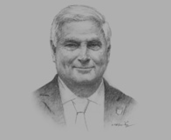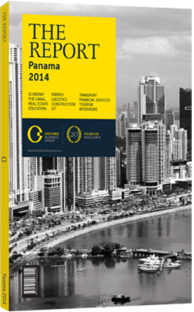OBG talks to President Ricardo Alberto Martinelli Berrocal
 President Ricardo Alberto Martinelli Berrocal
President Ricardo Alberto Martinelli Berrocal Interview: President Ricardo Alberto Martinelli Berrocal
With public investment in infrastructure at almost 9% of GDP, how sustainable is this going forward?
RICARDO ALBERTO MARTINELLI BERROCAL: My government has made a bigger investment in its five years of administration than any of the four previous presidential leaderships. After the death of General Omar Torrijos, there was a marked decrease in the amount of public investment. We can say that we have invested more than all the governments that preceded us in the past 40 years.
This infrastructure development is not a whim, but a necessity to allow us to create the conditions to continue growing at competitive levels globally. In part, this involves completing the modernisation of the Panamanian government, upgrading and automating most of its services, and applying technology to their processes. Moreover, finalising the expansion of the platform and multi-modal logistics services that relate to the Panama Canal, as well as the enlargement of the ports on both ends of the canal, is also a priority, as is the extension of the international airport. Another goal is the development of our international financial centre and the Colón Free Zone (CFZ), which is the largest in the region. All in all, in the medium term Panama will be in a strong position to advance to higher levels of social welfare and development.
We are allocating public investment in productive projects and infrastructure construction, including roads, hospitals and the Panama Metro, which will allow us to support the country’s ability to grow sustainably in the medium and long term. My government, at the end of its mandate, will have invested about $16bn, not counting the cost of the Panama Canal expansion project. The continuation of all these efforts is guaranteed. We created the Panama Savings Fund, so the next government will be able to invest up to $19bn. So, yes, public investment growth will be sustainable and the success of our economy, with the second-highest growth rate in Latin America, provides proof for the worth of this strategy. We are calculating a 6.5% jump in GDP, without counting the revenues from the canal, which will undoubtedly increase. Panama has been growing at an average of 8%, and the IMF supports our forecasts.
What incentives are planned to attract further private sector involvement in Panama’s growth?
MARTINELLI: The private sector is a key ally helping to move the wheels of progress. Beside the Panama Canal and business activities related to international maritime trade, we have in place a number of other strategic projects. These initiatives will help to lower the cost of electricity for businesses and manufacturers, as well as, for example, make food production and distribution both more efficient and cheaper. Such projects include the construction of a national “Cold Chain” to extend the life of fresh food, in addition to efforts to increase the use of wind, hydro or solar power to produce electricity. Further, the Panama Metro, which will cross the canal, modernisation of the road and highway networks, construction of new airports, and laws to stimulate national and international private investment, will also be key. At the same time that we are encouraging the growth of micro, small and medium-sized enterprises (MSMEs), efforts are also continuing to strengthen the agricultural sector to be self-sustaining and self-sufficient, which should bear fruit in the short to medium term. In addition, tourism is set to grow and contribute significantly to the national economy.
To what extent do free trade arrangements with Venezuela and Colombia slow regional integration?
MARTINELLI: There is not enough reliable information to show that differences of interpretation between Colombia and Venezuela on the one side, and the CFZ on the other, have the scope or the capacity for challenging the Panamanian free trade zone, nor the economies of these nations, and much less the processes of regional integration. Through different approaches and various bilateral agreements, we have advanced far enough with both Colombia and Venezuela to ensure that there are no such dangers of limited integration.
Given that foreign direct investment inflows have grown steadily, how can these be enhanced further?
MARTINELLI: Panama did its homework and the result is satisfactory. We sailed through the biggest economic crisis since 1929, during a time when it was necessary to remain cautious, yet daring when our needs and our situation allowed it. As a result, Panama is one of Latin America’s leading economies. We are on top for leadership and competitiveness in Central America and we are second in Latin America after Chile, above major economies like Mexico, Brazil and Argentina. That is not enough. We recognise that the effort should be consolidated and we should work on our weaknesses. Our challenges are those of the region, namely strengthening the rule of law, combatting insecurity and poverty, improving access to quality education, expanding health coverage and ensuring economic growth.
Producing skilled workers through education is a long process. How is Panama filling the gaps as well as bridging the digital divide?
MARTINELLI: The question is timely. First, we have no worries about inflation, as we have a banking centre connected to global markets through the London Interbank Offered Rate, which allows us a cushion mechanism to eliminate the possibility for uncontrolled money to move in and out of the country. Further, Panama’s economy is dollarised, which stabilises the value of money and means that we are open to all markets. All in all, the inflationary pressures in our economy are minimal and the country’s balance of payments is stable. As for the shortage of manpower with better qualifications, national education reform and training in specialised tasks is continuing through institutions created for that purpose, and which have produced excellent figures. Tasks that cannot wait will be carried out with foreign specialists hired for such purposes. Constant technological innovation in production processes, investment in education (the highest in Central America) and our efforts to modernise education and appropriate set skills are already paying off. Our competitiveness will not fall. This is indicated by international measurements, and we will continue moving at our pace, reaching realistic and encouraging milestones.
Telecommunications and the internet are empowering poorer citizens in urban and rural areas by creating a range of possibilities in education and remote training, while also helping to close the gap between rich and poor. We will continue to prepare people to fill the jobs that require special skills and expertise, appealing only to specialists from abroad if there are no Panamanians who can meet such skill sets.
What will drive development outside of the capital and the Panama Canal Zone?
MARTINELLI: Our socio-economic structure has been determined by our geographical position. The result of our connectivity is manifested by the fact that 81% of GDP and 80% of exports are in services. While the tertiary sector is performing strongly, the primary and secondary sectors are relatively underdeveloped. Panama needs to diversify into industries that are not related to transit. This includes an emphasis on those sectors that represent a higher percentage of GDP, including the agro-industry (19%), which we will develop further with the use of technology and choice of markets. Tourism, our second engine of income after the canal; fishing, an export pillar for 40 years; and mining already stand out with investment levels similar to the costs of the canal expansion. Our economy should be able to maintain a high level of public investment in the primary and secondary sectors to give an initial impulse.
The expanded canal will be an engine of growth, boosting productivity and diversifying industry. Public investment in infrastructure, such as highways and the metro, will give an impetus to businesses to continue to invest as will enhanced government services and public administration. At the same time, we must promote the growth of entrepreneurship, supporting MSMEs.
You have reached the limit of premium articles you can view for free.
Choose from the options below to purchase print or digital editions of our Reports. You can also purchase a website subscription giving you unlimited access to all of our Reports online for 12 months.
If you have already purchased this Report or have a website subscription, please login to continue.

